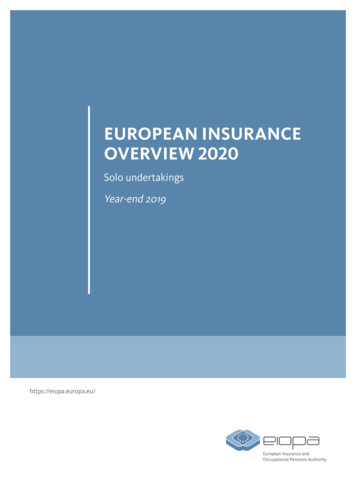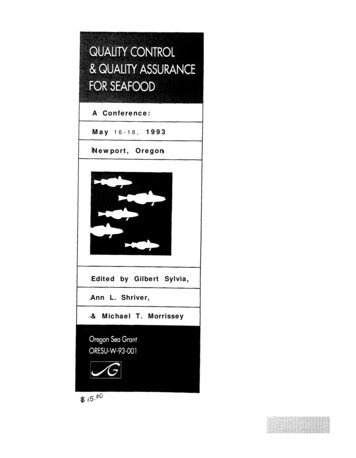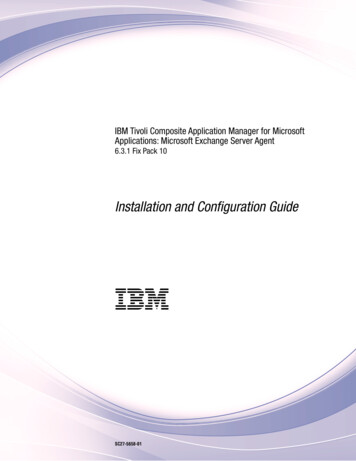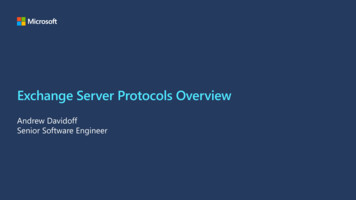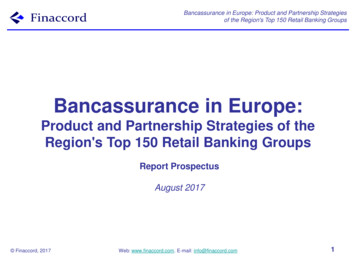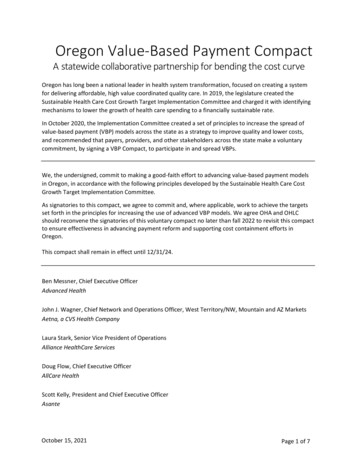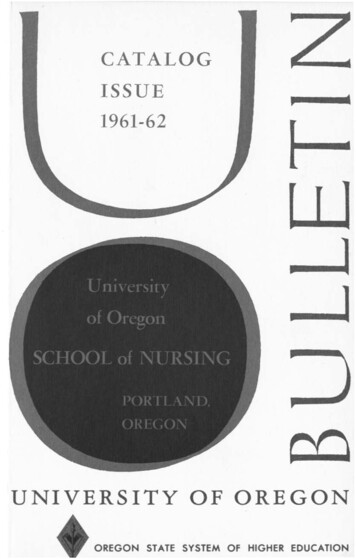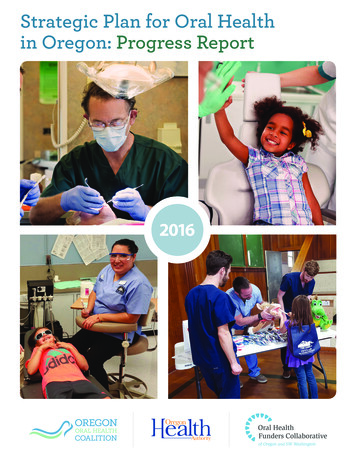
Transcription
Oregon Health Insurance Marketplace2018 Annual ReportApril 15, 2019FADepartment of Consumer and Business Services350 Winter St. NESalem, OR 97309855-268-3767www.oregon.gov/dcbs
Oregon Health Insurance Marketplace Report2018 Annual ReportTable of ContentsI.Introduction . 2II.Marketplace activities and operations . 4III.i.The Marketplace’s mission and leadership. 4ii.The Marketplace’s activities and operations . 4iii.Spotlight on open enrollment for the 2019 plan year . 6Who is covered . 8i.Marketplace enrollment . 8ii.Serving small businesses . 11IV. Insurance agents . 11V.Financial Condition . 12i.Overview . 12ii.Fund sustainability . 14April 15, 2019Page 1
Oregon Health Insurance Marketplace ReportI.IntroductionIn accordance with Oregon Revised Statute 741.222, the Department of Consumer and BusinessServices (DCBS) developed this 2018 annual report about the Oregon Health InsuranceMarketplace for the Legislative Assembly, Gov. Kate Brown, the Oregon Health Authority, andthe Oregon Health Policy Board.This report covers the following:1) The activities and operations of the Marketplace2) Who is covered and recommendations, if any, for additional groups to be eligible topurchase qualified health plans through the exchange under ORS 741.3103) A description of the role of insurance producers in the exchange4) A statement of financial condition, as of Dec. 31 of the previous year, for the HealthInsurance Exchange FundThe year followed a familiar pattern for the Marketplace. The individual market remainedstable in Oregon, federal policy changes presented some challenges to enrollment, and theMarketplace outreach team helped thousands of Oregonians get covered, despite theoccasional headwinds.By the time open enrollment closed on Dec. 15, 2018, 148,479 Oregonians had gotten coveragethrough HealthCare.gov. Although this was about a 5 percent drop from the previous year’senrollment, it remains a substantial community of consumers who needed affordable coverage,and found it through the Marketplace.The widespread confusion generated earlier by Affordable Care Act repeal activity in Congresshas largely subsided, but a few less-publicized policy changes could have weakened demand forMarketplace plans. Beginning with the 2019 plan year, there is no federal penalty for goingwithout insurance, a provision of the recent federal tax law changes.The federal government in 2018 used regulations to widen consumer access to short-term,limited-duration health plans. These products are riskier for the consumer than plans soldthrough the Marketplace because they are not required to cover pre-existing conditions, canput dollar caps on how much they will pay out for consumers’ claims, and often excludecoverage of many common medical services. At the same time, their lower premiums can beappealing. Oregon law keeps much narrower restrictions on the availability of short-term plans,but the adoption of the federal regulation may have sparked more interest in the products.These challenges emerged amid several great advantages for the Marketplace going in to theNov. 1 to Dec. 15, 2018, open enrollment period. Thoughtful work by the Division of FinancialRegulation and by the Marketplace’s carrier relations staff meant that plans were available onHealthCare.gov in every Oregon county, with an uptick in plan choices in most counties, and anincrease in choice of insurance company in two counties.In addition, the Marketplace’s technical structure as a state-based marketplace using thefederal platform (SBM-FP) meant the state was not vulnerable to federal decisions to furtherApril 15, 2019Page 2
Oregon Health Insurance Marketplace Reportcurtail advertising for open enrollment, and slash funding to the community groups that helppeople with their applications. Instead, Oregon stably funds and operates its own outreach,assistance, and advertising programs.As this report details, DBCS uses its state-based status to run Oregon-centered informationcampaigns, choose local groups to provide application assistance, send staff and materials tocommunity events, conduct Oregon-specific training for application assisters, and partner withlocal insurance agents.These roles all are essential to facilitating coverage for Oregonians, and I thank our partnersacross state government and in the community for their interest in our work.Sincerely,Cameron Smith, DCBS DirectorApril 15, 2019Page 3
Oregon Health Insurance Marketplace ReportII.Marketplace activities and operationsThe activities and operations of the department in administering the Marketplace during theprevious yeari.The Marketplace’s mission and leadershipThe Marketplace’s mission is to empower Oregonians to improve their lives through localsupport, education, and access to affordable, high-quality health coverage. To serve its mission,the division works closely with stakeholders and partners, including insurers, insurance agents,community partners, tribes, small businesses, trade and industry groups, health care providers,advocates, the Legislature, the Governor’s Office, the Oregon Division of Financial Regulation(DFR), the Oregon Health Authority (OHA), and the Centers for Medicare and Medicaid Services(CMS).The Marketplace is a division of the Department of Consumer and Business Services, led byDirector Cameron Smith and Administrator Chiqui Flowers.The Marketplace Advisory Committee continues to provide insights and recommendations tothe Marketplace. The 2018 members of the committee were: Kraig Anderson, chief actuary, Moda Health, Portland Shonna Butler, life and health insurance broker, Tomlin Benefit Planning, Inc., Eugene Stephanie Castano, program coordinator, Oregon Primary Care Association, Portland Cindy Condon, health plan enrollee, Salem Joe Enlet, consul general, Consulate General of the Federated States of Micronesia,Portland Dan Field, executive director, Community Benefit and External Affairs, KaiserPermanente Northwest, Portland Jim Houser, owner, Hawthorne Auto Clinic, Portland Sean McAnulty, consumer advocate, Portland Mark Griffith, health care advocate, OSPIRG, Portland Ken Provencher, chief executive officer, PacificSource Health Plans, Springfield Shanon Saldivar, insurance agent, Revell Coy Insurance, The Dalles Jennifer Welander, chief financial officer, St. Charles Health System, Bend Cameron Smith, director of DCBS (ex-officio member) Jeremy Vandehey, director, Health Policy and Analytics, OHAii.The Marketplace’s activities and operationsThe Marketplace serves Oregonians by providing: Access to a range of qualified health plans (QHPs), allowing individuals and families findthe right coverage Pathways to access subsidies that help pay for premiums and out-of-pocket costs Information to help consumers learn about health care coverage Consumer assistance through an outreach center, staff in the field, and trained andcertified agents and community partner organizationsApril 15, 2019Page 4
Oregon Health Insurance Marketplace ReportDetailed examples of this work are highlighted in this section.The Community Partner Program certifies and supports community groups that educateOregonians on health plan options and help people in enroll in coverage throughHealthCare.gov and other programs.The program directly funds seven community groups that become experts in HealthCare.govapplications and private-plan enrollment, and assist Oregonians with both Oregon Health Planand HealthCare.gov enrollment. The grantees also conduct outreach activities to publicizehealth insurance options. They specialize in reaching underserved populations and limitedEnglish-proficiency Oregonians.Calendar year 2018 comprised the end of the 2018 grant cycle (September 2017 throughAugust 2018 at 370,135) and the beginning of the 2019 grant cycle (September 2018 to July2019 at 500,000) for the Marketplace’s Community Partner Program.In 2018, the Marketplace’s seven community-partner grantees: Facilitated 1,830 enrollments in private plans through HealthCare.govProvided assistance, whether or not resulting in an enrollment, 21,883 times*In conducting outreach, made contact with Oregonians 1,141,147 times*Many other community groups serve as community partners supervised by the Oregon HealthAuthority and mainly assist people eligible for the Oregon Health Plan. The Marketplaceprovides these organizations with cross-training in HealthCare.gov’s eligibility and enrollmentprocesses. The Marketplace’s team maintains contact with OHA community partnersthroughout the year to answer questions, provide updates on any policy changes atHealthCare.gov, and help resolve any difficulties the groups’ clients have with HealthCare.gov.* These measure “times,” not people, as the same person may have been assisted or contactedmore than once.The Outreach and Customer Service Program is made up of six Marketplace staff memberswho publicize Marketplace services at community events, hold in-person information sessionsabout coverage, and answer phone calls from consumers.Most outreach team members serve a specific region of the state, frequently traveling to their“territory.” One outreach team member is fluent in Spanish and serves the entire state inpartnership with each regional outreach staffer, providing bilingual, culturally appropriateoutreach. The outreach team also is supported by a Marketplace tribal liaison, who collaboratesdirectly with Oregon’s tribes and who advises the outreach team on assisting Native Americansand Alaska Natives in the course of their statewide outreach.Part of the team’s work includes attending OHA-sponsored regional collaborative meetingswhere OHA-sponsored assisters, other community groups, and Marketplace staff membersApril 15, 2019Page 5
Oregon Health Insurance Marketplace Reportshare enrollment information, spread best practices, and jointly solve problems involvingenrollment or outreach.In 2018, the outreach and customer service staff: Attended 290 regional collaborative meetings, attended by 3,702 people Represented the Marketplace at 317 public events, attended by 22,939 people Handled 5,612 phone calls from the publicThe COFA Premium Assistance Program is operated by the Marketplace. It serves low-incomecitizens of the Federated States of Micronesia, the Republic of the Marshall Islands, and theRepublic of Palau who live in Oregon. Under the Compact of Free Association, these citizens arepermitted to reside in the United States, but COFA adults are not eligible for full Medicaid (theOregon Health Plan) under federal law. The COFA Premium Assistance Program pays theenrollees’ share of premiums for medical insurance purchased through HealthCare.gov. Theprogram also reimburses enrollees’ spending on in-network services that count towardmaximum out-of-pocket costs under the plan. The Marketplace’s COFA program team overseesoutreach and education to the COFA community and processes program applications andreimbursement claims.For the 2018 plan year: 627 applications were received and processed672 people were enrolled in the programBy the end of 2018, 514 people were actively enrolled in the program (there was some attritionduring the year).The Partner Agent Program provides licensed insurance agents with updates and resourcesfrom HealthCare.gov, and with timely information about the plans sold in Oregon onHealthCare.gov. When insurance agents and their clients encounter problems or errors withHealthCare.gov that cannot be fixed directly, the Marketplace works with our federal partnersto resolve the issue.The Marketplace also operates a competitive grant program to support agents’ capacity to helpHealthCare.gov applicants during open enrollment. Agents earning grant funding are evaluatedon multiple criteria, including their demonstrated ties to community networks, ability to reachunderserved populations, and ability to serve consumers whether they are eligible forHealthCare.gov plans or other programs, such as the Oregon Health Plan or Medicare.Thirty-three insurance agents, called partner agents, received grants totaling 321,500 for theperiod that began in July 2018. More information on the activities of the partner agents isincluded in Section IV of this report.iii.Spotlight on open enrollment for the 2019 plan yearCalendar year 2018 included the open enrollment period for the 2019 plan year, which ran Nov.1 to Dec. 15, 2018. For the 2019 plan year, Oregon continued to use HealthCare.gov forindividual eligibility and enrollment in QHPs.April 15, 2019Page 6
Oregon Health Insurance Marketplace ReportIn the months leading up to open enrollment, the Marketplace developed a thorough outreachand education campaign plan to provide information, resources, and help to Oregoniansseeking health insurance. The goals of the campaign were to:1. Convey key enrollment information (enrollment deadline, availability of applicationassistance and financial assistance) to Oregonians likely eligible for subsidies2. Drive enrollment in Marketplace plans3. Build trust with customers and stakeholdersIn addition to promoting coverage to all Oregonians, the Marketplace targeted some keygroups. Analysts at the Urban Institute and the State Health Access Data Assistance Centerestimated the number of Oregonians throughout the state who were eligible to enroll throughHealthCare.gov and who, based on income, were likely to qualify for financial assistance. Usingthis information, target populations included: Men Adults born after 1980, sometimes called “Millennials” Latino Oregonians People in the following regionso Portland-area Clackamas Countyo Yamhill and Polk countieso Columbia, Lincoln, Clatsop and Tillamook countieso Multnomah County and Portland City easto Linn and Benton countieso Jackson Countyo Deschutes Countyo HillsboroOpen enrollment outreach – both general and targeted – was accomplished through multiplemethods, including: In-the-field outreach and education, including enrollment events and sponsorships ofpublic events The Partner Agent program The Community Partner program Social media Consumer and small-business outreach materials Information and resources through the state website OregonHealthCare.gov Information and resources through Oregon’s call center A thorough paid-media campaignThe paid-media campaign included: TV ads in English and Spanish the following markets: Portland, Eugene, Bend, MedfordKlamath Falls, Ashland-Grants Pass, and Pendleton-Hermiston Radio ads in Spanish in Portland, the Mt. Hood area, the Willamette Valley, Eugene,Bend, and Medford Radio ads in Russian on three stations in Portland, and in English on one station inPortlandApril 15, 2019Page 7
Oregon Health Insurance Marketplace Report III.Print ads in English in newspapers in Astoria, Beaverton, Cannon Beach, Dallas,Gresham, Lake Oswego, Lincoln City, McMinnville, Newberg, Newport, Oregon City,Sandy, Seaside, Tigard, Tualatin, West Linn, Wilsonville, and YamhillPrint ads in Spanish in newspapers in Portland and the Willamette ValleyPrint ads in Russian in newspapers in PortlandAds on Google in English and Spanish, served when people searched for healthinsurance informationDisplay (nonmoving) ads in English and Spanish on Facebook and general websitesVideo ads in English and Spanish on Facebook, YouTube, Hulu, and general websitesWho is coveredWho enrolled in the Marketplace and recommendations, if any, for additional groups to beeligible to purchase qualified health plans through the exchange under ORS 741.310Enrollment through the Marketplace for 2019 coverage dipped slightly compared to 2018coverage. Total enrollment by the end of the open enrollment period was 148,479, a 5 percentdrop. After the plan year began, the Marketplace learned that the number of enrollees whopaid their first 2019 premium (effectuated their coverage) rose compared to the 2018 planyear. The number who effectuated 2019 coverage was 140,905, compared to 140,176effectuations for 2018 coverage.At this time, DCBS does not have any recommendations for additional groups to be eligible topurchase qualified health plans through the exchange.i.Marketplace enrollmentThe following 2019 enrollment data was reported by the Centers for Medicare and MedicaidServices. These data show plan selections during open enrollment.Total On-Marketplace EnrollmentBy Dec. 15, 2018By Dec. 15, 2017(2019 plan year)(2018 plan year)148,479156,105Applications and EligibilityApplicationsIndividuals on applicationsEligible for MarketplaceEligible with financial helpEligible for Medicaid141,253205,819173,273123,85131,951New and Returning CustomersNew enrollees35,617 (24%)Returning enrollees112,563 (76%)April 15, 2019Page 8
Oregon Health Insurance Marketplace ReportAuto-enrolled returningenrolleesActive returning enrollees27,512(19% of all customers)85,051(57% of all customers)Active returning whochanged plansCustomers Receiving SubsidiesPercent of customersreceiving financial helpPercent with APTC*Percent with cost-sharingreductionsAverage APTC amongconsumers receiving APTC48,87575%74%34% 455*Advance Premium Tax CreditEnrollment by GenderFemaleMale55%45%Enrollment by Age*Age 1818-2526-3435-4445-5455-64 648%7%17%17%18%31%1%*Percentages do not total 100 due to roundingEnrollment by Metal TierBronzeSilverGoldPlatinumCatastrophicEnrollment by Race/Ethnicity*American Indian/AlaskanNativeAsianBlackHawaiian/Pacific IslanderLatinoApril 15, 201939%50%10%0% 1% 1%7%1% 1%6%Page 9
Oregon Health Insurance Marketplace ReportMultiracialWhiteUnknown/Not reported3%67%20%*Percentages total more than 100 because people who identify as Latino may be of any raceEnrollment by Income Level 150% FPL*150%-200% FPL200%-250% FPL250%-300% FPL300%-400% FPLOther income level**9%22%17%12%18%21%*Federal Poverty Level. FPL for plan year 2019 is 12,490 per year for an individual and 25,750 for ahousehold of four.**Incomes above 400% FPL and unknown incomesEnrollment by CountyBaker CountyBenton CountyClackamas CountyClatsop CountyColumbia CountyCoos CountyCrook CountyCurry CountyDeschutes CountyDouglas CountyGilliam CountyGrant CountyHarney CountyHood River CountyJackson CountyJefferson CountyJosephine CountyKlamath CountyLake CountyLane CountyLincoln CountyLinn CountyMalheur CountyMarion CountyMorrow CountyMultnomah CountyPolk CountySherman CountyTillamook CountyApril 15, 896458,75520236,5332,120701,121Page 10
Oregon Health Insurance Marketplace ReportUmatilla CountyUnion CountyWallowa CountyWasco CountyWashington CountyWheeler CountyYamhill County1,45997546176518,738612,986ii.Serving small businessesThe Marketplace helps small businesses understand health insurance options for theiremployees.The Marketplace’s small business program does outreach statewide through partnerships withSmall Business Development Centers, local Chambers of Commerce, industry organizations, andother organizations that counsel or advocate small businesses. The outreach ranges from largegroup presentations, resource workshops, and small-business networking events. The programalso collaborates with other state agencies engaged with small business owners, including theSecretary of State’s small-business ombudsman, the Bureau of Labor and Industries, andBusiness Oregon.The Marketplace continues to help qualified employers take advantage of the small businesshealth care tax credit. Any small business in Oregon with one to 50 employees can purchase acertified plan directly from one of the participating insurers or through an insurance agent. Ifthe small business has fewer than 25 full-time employees, it may be eligible for the smallbusiness health care tax credit. The insurer can contact the Marketplace to request a letterconfirming that the plan purchased is certified, and the employer can use the letter to file forthe tax credit from the IRS. This process was first implemented in 2014.In 2018: IV.122 small businesses used the Marketplace’s process900 people were covered on those plansThe businesses chose plans from among four insurance companies offeringMarketplace-certified plansInsurance agentsA description of the role of insurance producers in the exchangeInsurance agents continue to be vital for educating consumers about health plan options andhelping them enroll in coverage. The Marketplace’s partner agents report that clients value inparticular the agents’ expertise in provider-network variations across plans and year-to-yearchanges in out-of-pocket charges required under each plan design.From Nov. 1 through Dec. 15, 2018, the open enrollment period for the 2019 plan year:April 15, 2019Page 11
Oregon Health Insurance Marketplace Report About 48,949 Oregonians enrolled in HealthCare.gov plans were assisted by aninsurance agento 14,700 of those enrollments were facilitated by the Marketplace’s partneragents 4,260 of the partner agents’ enrollments were new clients 10,440 of the partner agents’ enrollments were existing clientsMore information on the partner agent program is in Section II, Pages 4-5, which describes theMarketplace’s activities.V.Financial ConditionA statement of financial condition, as of Dec. 31, 2018, for the Health Insurance Exchange Fundi.OverviewThis section discusses the financial condition of the Health Insurance Exchange Fund as of Dec.31, 2018. Budget or fiscal activities after that date are not reported here. All amounts discussedbelow exclude the Compact of Free Association Premium Support Program and the SeniorHealth Insurance Benefit Assistance Program because those programs are not funded by theHealth Insurance Exchange Fund.The Marketplace is financially stable and self-sufficient for the remaining six months of the2017-19 biennium. As of Dec. 31, 2018, the Marketplace can fund approximately 11 months ofactivities with a fund balance of 6.6 million.The 2017-19 biennium budget for the Oregon Health Insurance Marketplace is shown here:2017 - 2019 Legislatively Adopted Marketplace BudgetSectionMarketplaceShared ServicesTotal2017 - 2019 51717.00Through the end of the biennium, the Marketplace is expected to use about 79 percent of itslimitation. The Marketplace expects to use a significantly larger portion of its limitation in the2019-21 biennium due to: A 1 million reduction in its limitation for IT services. The purchase of a consumer choice tool that will allow Oregonians to have a moreefficient plan choice experience than is currently offered through the federal tool. TheMarketplace expects to spend about 500,000 per biennium on this tool. This is an offthe-shelf product.Through December 2018, the Marketplace has used 110 percent of the allowed shared servicelimitation. The Marketplace has discussed this with the Legislative Fiscal Office and isrequesting additional shared service limitation to meet the expected biennium cost.April 15, 2019Page 12
Oregon Health Insurance Marketplace ReportOregon Health Insurance Exchange 2017 - 2019 LAB and ActualsSectionMarketplaceShared Services2017 2019 LAB14,917,4071,012,108ActualExpenditures asof 12/31/2018Projection 1/2017- 6/2018Actual 82,0031,710,000VarianceOver/(Under)% Variance ((Actuals Projected) / LAB)(3,135,404)697,89279%169%The following table shows revenues for the Health Insurance Marketplace during CY 2018.Oregon Health Insurance Exchange CY 2018 Balances and RevenuesAccount DescriptionBeginning 822018Q46,858,129Year TotalPMPM Assessment – MedicalPMPM Assessment – DentalInterest and InvestmentsOther 7432,010,4272,623,2499,629,706TotalThe following table shows CY 2018 Health Insurance Marketplace expenditures.Oregon Health Insurance Exchange CY 2018 Expenditures and TransfersAccount DescriptionPersonal 8Q4543,740Year Total2,036,627Services and SuppliesTravelEmployee TrainingOffice ExpensesTelecommunicationsState Government Service ChargesData ProcessingPublicity and PublicationsProfessional ServicesIT Professional ServicesAttorney General Legal FeesFacility Rent and TaxesExpendable PropertyOther Services and ,956,9742,847,536Services and Supplies TotalApril 15, 2019Page 13
Oregon Health Insurance Marketplace ReportDistribution to GranteesCapital 32,291Total 837670,917213,3280228,7741,113,019Total Expenditures with Shared 4600464,129,0835,625,7826,858,1296,560,156Shared ServicesOther transfersEnding Fund BalanceThe 2018Q4 growth in publicity and publications over 2018Q3 is a typical expenditure patternfor the Marketplace. It reflects Marketplace outreach efforts at the beginning of openenrollment.ii.Fund sustainabilityMarketplace Per Member Per Month (PMPM) assessment: Oregon’s Marketplace is primarilyfunded through a per member per month fee. These fees apply only to plans purchasedthrough the federal exchange. In 2018, the fee for medical plans was 6 per member per monthand 57 cents per member per month for dental plans. Assessments for the 2019 plan year arethe same. The Marketplace anticipates lowering the PMPM assessment to 5.50 for medicalplans and 36 cents for stand-alone dental plans for the 2020 plan year. There have beensignificant reductions in operating costs over the last several years as the Marketplacecontinues to adopt cost-saving operational changes.Federal technology fee: The federal technology charge to insurers was 2 percent of the averagepremium for plan year 2018. Oregon Revised Statute 741.105(2)(a) limits the Marketplace’sassessment to no more than 5 percent of premium. The Marketplace’s position is that theMarketplace’s per member per month fee plus the federal platform charge should be below 5percent of premium. The total PMPM plus federal technology fee was 3.1 percent of premiumin 2018. The Marketplace expects it to be 4.1 percent for plan year 2018. Please note that theincrease from plan year 2018 to 2019 is due to expected cost increases for the federaltechnology assessment. We expect the federal technology fee to be 2.5 percent for the 2020plan year.Enrollments: Medical enrollment for the 2018 plan year was almost 4 percent higher thanforecast. The Marketplace expected, on average, about 124,400 medical policies each month.There were actually about 129,100 medical policies each month. Dental enrollment for the2018 plan year was also almost 18 percent higher than forecast. The Marketplace expected17,300 monthly dental policies on average. There were actually 20,400 dental policies onaverage each month during the plan year. The forecast numbers are from April 2017 andrepresent the data the Marketplace based their 2018 assessment rate decision on. Please notethat actual enrollment counts may be updated by insurers until June 2019.April 15, 2019Page 14
Oregon Health Insurance Marketplace ReportOregon Health Insurance Exchange CY 2018 st 417119,14614,932114,07614,847124,39117,310Actual 801121,66718,785119,94318,362129,11720,367Absolute forecast 42,597392,3842,5213,8535,8673,5154,7263,057The pattern in the forecast error is due to changes in the seasonality of medical planenrollment. This was driven by the open enrollment period being reduced from 90 days to 45days by the federal government.The 2018 forecast was based on federal law at the time of
Oregon Health Insurance Marketplace 2018 Annual Report April 15, 2019 FA Department of Consumer and Business Services 350 Winter St. NE Salem, OR 97309 . (DFR), the Oregon Health Authority (OHA), and the Centers for Medicare and Medicaid Services (CMS). The Marketplace is a division of the Department of Consumer and Business Services, led by

